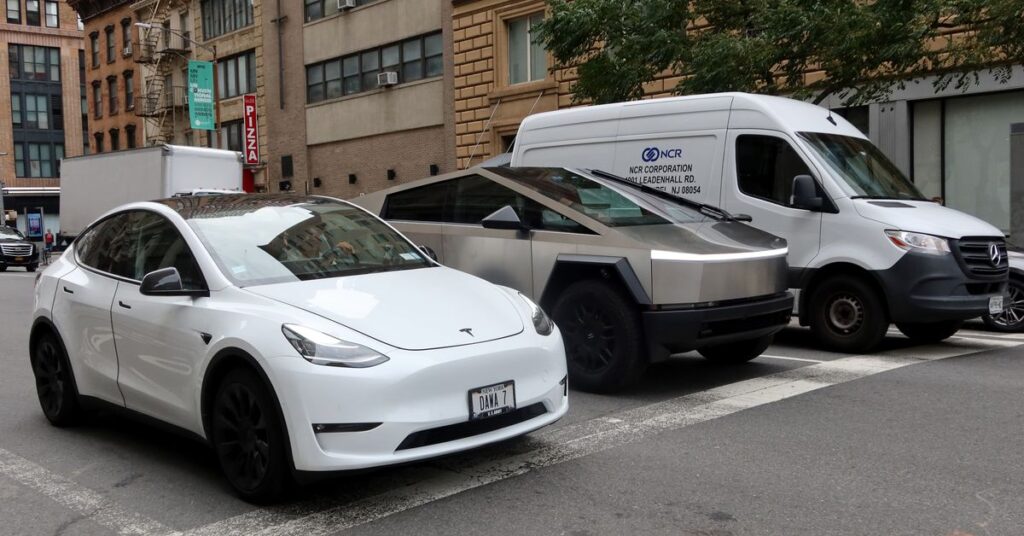Do Tesla robotaxis have steering wheels? Elon Musk won’t say.
The Tesla CEO sidestepped several questions during Tuesday’s earnings call about the status of the company’s long-promised self-driving car, including whether it would have traditional controls like pedals and a steering wheel.
It’s an increasingly important issue in Tesla’s robotaxi program, which has been delayed to allow more work on prototypes. In theory, it could take months or even years before a vehicle without a steering wheel and pedals is allowed to drive on public roads. Meanwhile, a more traditional-looking vehicle may be released sooner.
In theory, steering wheel- and pedal-less vehicles could take months or even years to be approved.
That’s because Tesla needs federal approval to deploy its more radically designed robotaxis, something Tesla acknowledged in its letter to shareholders.
“While the timing of Robotaxi deployment is dependent on technological advancements and regulatory approvals, we are actively pursuing this opportunity given its significant potential value,” the company said.
However, when asked specifically what regulatory approvals Tesla would seek, Musk declined to answer.
Specifically, he was asked whether Tesla would seek an exemption from federal motor vehicle safety standards to deploy vehicles without traditional controls. He responded by comparing Tesla’s “universal solution” to Waymo’s more “localized” solution, which he called “pretty fragile.”
“Our solution is a universal solution that can be used anywhere,” he added. “It could even work on different Earths.”
Currently, the Federal Motor Vehicle Safety Standards (FMVSS) require cars to be equipped with basic user-friendly controls such as steering wheels, pedals, side-view mirrors, etc. These standards dictate how a vehicle must be designed before it can be sold in the United States. If a proposed new vehicle does not comply with all existing FMVSS, manufacturers can apply for an exemption. But the government only provides 2,500 exemptions per company each year.
“It could even work on different Earths.”
In theory, the exemption cap would prevent any self-driving company, including Tesla, from deploying purpose-built autonomous vehicles at scale. Supporters of self-driving cars have tried to pass legislation to lift the cap and allow more self-driving cars on public roads, but the bill has stalled in Congress over issues of technical liability and readiness.
So far, only one company has received an FMVSS exemption: Nuro, which has used them to deploy a small number of driverless delivery robots in Texas and California. Cruise, owned by General Motors, applied for an FMVSS exemption for its steering-wheel- and pedal-less Origin shuttles, but the application was never approved and now the Origin is on hold indefinitely. Amazon’s Zoox said its self-driving shuttles are “self-certified,” prompting an investigation by the National Highway Traffic Safety Administration.
Other companies choose to skip this step entirely. Waymo’s self-driving vehicles all use traditional controls, despite operating on public roads without safety drivers. The company said it will eventually launch a steering wheel-less car, but has not said when or if it will seek an FMVSS exemption.
All this suggests Tesla faces similar regulatory hurdles depending on whether it decides to give up traditional controls. There have been some hints along the way, such as blueprints showing a steering wheel-less area of the vehicle.
Critics have dismissed claims that Tesla robotaxis have fogging software, pointing out that Waymo rides close to 50,000 passengers a week, while Musk continues to make claims about a vehicle that has never been seen and may never actually exist. Make vague promises.
Musk has undoubtedly bet the company on this, repeatedly emphasizing that Tesla is fundamentally an artificial intelligence company, not a traditional car company. However, he wouldn’t reveal the real obstacles the company may face in trying to realize this vision.
We’ll have to wait until October to get a real answer, or possibly even later, pending further delays.

